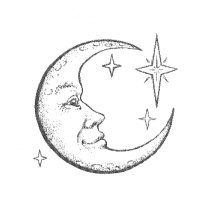Scanned at sacred-texts.com, November 2003. J. B. Hare, redactor. This text is in the public domain. These files may be used for any non-commercial purpose, provided this notice of attribution is left intact.
Moon Lore by Rev. Timothy Harley. 1885
PREFACE
"And when the clear moon, with its soothing influences, rises full in my view,--from the wall-like rocks, out of the damp underwood, the silvery forms of past ages hover up to me, and soften the austere pleasure of contemplation."
Goethe's "Faust." Hayward's Translation, London, 1855, p. 100.
THIS work is a contribution to light literature, and to the
literature of light. Though a monograph, it is also a medley.
The first part is mythological and mirthsome. It is the
original nucleus around which the other parts have gathered. Some
years since, the writer was led to investigate the world-wide
myth of the Man in the Moon, in its legendary and ludicrous
aspects; and one study being a stepping-stone to another, the
ball was enlarged as it rolled.
The second part, dealing with moon-worship, is designed to
show that anthropomorphism and sexuality have been the principal
factors in that idolatry which in all ages has paid homage to the
hosts of heaven, as heaved above the aspiring worshipper.
Man adores what he regards as higher than he. And if the moon is
supposed to affect his tides, that body becomes his
water-god.
The third part treats of lunar superstitions, many of which
yet live in the vagaries which sour and shade our modern
sweetness and light.
The fourth and final part is a literary essay on lunar
inhabitation, presenting in nuce the present state of the
enigma of "the plurality of worlds."
Of the imperfections of his production the author is partly
conscious. Not wholly so; for others see us often more
advantageously than we see ourselves. But a hope is cherished
that this work--a compendium of lunar literature in its least
scientific branches--may win a welcome which shall constitute the
worker's richest reward. To the innumerable writers who are
quoted, the indebtedness felt is inexpressible.

